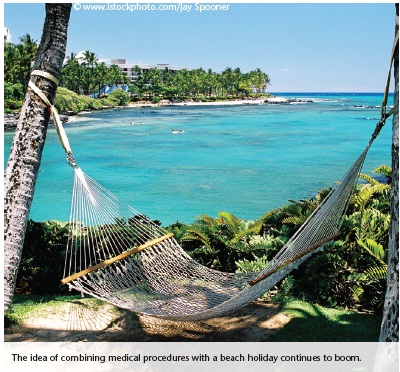Danielle Tate-Stratton explores medical tourism in Asia
We’ve all been long aware of the benefits of popping over to one of Japan’s neighboring countries such as Thailand or Malaysia for some rest, relaxation, and mental healing. What we may not be so aware of, however, is the potential for combining your relaxing vacation with some true physical healing. Medical tourism, as it has come to be known, is the latest boom in specialty travel. According to Hotelmarketing.com, as of 2006, over one million people per year visited Thailand alone to get treatment as a part of the medical tourism industry, which is growing at a rate of 20–30 percent across Asia compared to a 4 –5 percent increase in the traditional travel sector.
Patients from around the world, including a large proportion that originate from Asian countries, flock to Thailand, Malaysia, India, Singapore, and others, drawn by promises of high quality procedures, low wait times, and even lower costs when compared to traveler’s home countries. In Malaysia for instance, a hip replacement may cost you $5,000 versus $45,000 in the US.
Of course, while there can be huge rewards (and savings) for combining your vacation with a life-saving or life-enhancing medical procedures, there are risks. Ensure that any hospital you chose to visit is certified internationally (for instance with the TRENT [European- ased] or JCI [US-based] systems), has doctors trained by a medical system you trust, and hires English speaking doctors or translators. Also be aware that while the care you receive in these world-class facilities is likely to be just that, the countries you are in may be risky in and of themselves. Also keep in mind that long flights can exacerbate medical issues such as thrombosis and that depending on your insurance policy, you may not be able to be evacuated back home or to Japan if necessary. However, the low cost, generally high standards of care, quality training, and cutting-edge technology, as well as the chance to hit a pristine beach in order to get some post-op R&R can make traveling abroad for medical treatment a very tempting proposal.
So what type of procedure can you combine with your trip to the beach? At this point, just about anything! Following is a quick rundown, though by no means complete, of the services and specialties offered in several nearby Asian countries.
Thailand
With high volume of patients and doctors and hospitals experienced in hosting international patients, Thailand is well known in this industry. The Bumrungrad International Hospital in Bangkok (www.bumrungrad.com), hosts 400,000 international patients per year, has thirty specialty clinics, and holds the Red Cross designation of ‘A’, the highest a hospital can receive. One or more of the hospital’s 945 internationally trained doctors and 700 nurses will be happy to provide you with services ranging from plastic surgery to cardiac procedures, and more. Looking for somewhere to stay? The hospital has that covered as well, offering two connected residences with studio apartments from under ¥6,000 a night.
Another top option in Thailand is the Bangkok Hospital and Medical Center (www.bangkokhospital.com), which boasts doctors from over 100 nationalities speaking over 30 languages. The 35-year-old network of hospitals and clinics offers package deals including stroke- revention, dental care, and plastic surgery, and even employs its own concierge to help you plan your journey to and from Thailand and find a place to stay in their serviced-apartments or an off-property location. For those who wish to more fully incorporate the tourism aspect of medical tourism into their stay, the hospital even has a Pink Rose Holidays (www.pinkroseholidays.com) service desk in their lobby! For example, try a three-day/two-night getaway to the four-star Woraburi Phuket Resort and Spa (www.woraburi.com) for just ¥38,000 including flights, hotel, and breakfast.
Singapore
Over 200,000 international patients visit Singapore each year and according to Hotelmarketing.com, it is quickly amassing a reputation for world-class neurosurgery techniques. For instance, the National Neuroscience Institute (www.nni.com.sg), which treats both international and domestic patients at both the Tan Tock Seng Hospital and Singapore General Hospital, offers treatments in neuroradiology, neurosurgery, pediatric neurology, and more, offering specialized treatment at a fraction of the cost of what it might be in the US.
India
India is gaining prominence on the international medical scene and expects to see $2.2billion worth of medical tourism by 2012. With internationally managed corporate hospitals run by names such as The Apollo Group and Escorts Hospitals, India is well-positioned to offer you low-cost treatments for anything which ails you. With over 150,000 international patients per year, low or non-existent wait times, and savings of over 50 percent compared to the US in many cases, India is ready to break onto the medical tourism scene in a big way.
The Apollo Hospital Group, with its 37 hospitals, is also giving back to it’s own country by supporting India’s poor—offering free beds to those who can’t afford care, setting up trust funds, and pioneering satellite tele-medicine across India. In a sector where many services can seem similar, knowing you are supporting a company that gives back may be just the incentive for the socially conscious traveller. Medical Tourism India offers medical, vacation, and medical tourism packages to India.
Malaysia
According to Hotelmarketing.com, Malaysia is a country fairly new to the international medical scene with over 100,000 patients per year visiting the country. Tourism Malaysia actively promotes ‘health’ as an activity and says, “medical expertise in Malaysia ranks among the best in the world and most private hospitals in the country have internationally recognized quality and standards.” They have also launched a new website, www.malaysiahealthcare.com, designed to help you plan your treatment and tour packages.









